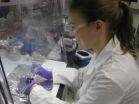(Press-News.org) Men who show signs of chronic inflammation in non-cancerous prostate tissue may have nearly twice the risk of actually having prostate cancer than those with no inflammation, according to results of a new study led by researchers from the Johns Hopkins Kimmel Cancer Center.
The link between persistent inflammation and cancer was even stronger for men with so-called high-grade prostate cancer — those with a Gleason score between 7 and 10 — indicating the presence of the most aggressive and rapidly growing prostate cancers.
"What we've shown in this observational study is a clear association between prostate inflammation and prostate cancer, although we can't prove that inflammation is a cause of prostate cancer," said Elizabeth A. Platz, Sc.D., M.P.H., a professor in the Department of Epidemiology at the Johns Hopkins University Bloomberg School of Public Health and the School of Medicine.
Cancer researcher Angelo M. De Marzo, M.D., Ph.D., cautioned that inflammation is too widespread in men to be used as a diagnostic tool for prostate cancer. However, researchers want to know more about what causes prostate inflammation, how it may contribute to prostate cancer, and whether this inflammation may be prevented. "I think there will be strategies going forward for either preventing inflammation or intervening when it occurs," Platz said.
The findings, reported April 18 in Cancer Epidemiology, Biomarkers & Prevention, come from analysis of information about men in the placebo-taking group of the Southwest Oncology Group's Prostate Cancer Prevention Trial. That trial, designed to learn whether the drug finasteride could prevent prostate cancer, included biopsies for prostate cancer at the end of the study even if there were no suspicious signs of cancer such as high prostate specific antigen (PSA) levels.
Researchers have examined possible links between inflammation and prostate cancer in other studies, but the previous studies began by sampling tissue from men who had some cause to undergo a biopsy, Platz explained. "Our study was designed to rule out the bias that would ordinarily exist between the way we detect prostate cancer and the presence of inflammation."
"Because inflammation makes PSA levels go up, men with inflammation are more likely to have higher PSA and, with a rising PSA, they're more likely to be biopsied," she said. "By doing more biopsies on these men, prostate cancer is more likely to be detected, even if inflammation is not a cause of prostate cancer."
For the study, Platz, De Marzo and colleagues examined benign tissue samples taken from the biopsies of 191 men with prostate cancer and 209 men without cancer, examining the samples for the prevalence and extent of immune cells that indicate inflammation. They found that 86.2 percent of the prostate cancer patients had at least one tissue sample with signs of inflammation, compared to 78.2 percent of men without cancer.
"We knew going into this research that inflammation in the prostate is very common in men who have biopsies because of the higher PSA levels and other indicators of prostate cancer," said De Marzo, who is a professor of pathology at Johns Hopkins' School of Medicine and associate director of cancer research pathology at its Kimmel Cancer Center, "but we did not anticipate the high prevalence of prostate inflammation in men who didn't have an indication for biopsy."
Ultimately, men with at least one tissue sample showing signs of chronic inflammation had 1.78 times higher odds of having prostate cancer, and 2.24 times higher odds of having an aggressive cancer, the researchers concluded. The association held firm even in men with low PSA levels at the time of their biopsies.
The Johns Hopkins team is studying the relationship between PSA levels and detailed measures of inflammation in men with no indications for a prostate biopsy, as well as a potential link between sexually transmitted disease history and the amount of inflammation in the prostate.
INFORMATION:
Other scientists involved in the study were Bora Gurel, Charles G. Drake, William G. Nelson and Sarah B. Peskoe from Johns Hopkins; M. Scott Lucia from the University of Colorado School of Medicine; Ian M. Thompson Jr. from the University of Texas Health Sciences Center San Antonio; Phyllis J. Goodman, Catherine M. Tangen, and Alan R. Kristal from Fred Hutchinson Cancer Research Center; Howard L. Parnes from the National Institutes of Health; Ashraful Hoque from the University of Texas MD Anderson Cancer Center; Scott M. Lippman from the University of California, San Diego; and Siobhan Sutcliffe from Washington University School of Medicine.
The work was supported by the National Institutes of Health's National Cancer Institute (P01 CA108964, U10 CA37429, and P50 CA58236).
JOHNS HOPKINS MEDICINE
Johns Hopkins Medicine (JHM), headquartered in Baltimore, Maryland, is a $6.7 billion integrated global health enterprise and one of the leading health care systems in the United States. JHM unites physicians and scientists of the Johns Hopkins University School of Medicine with the organizations, health professionals and facilities of The Johns Hopkins Hospital and Health System. JHM's mission is to improve the health of the community and the world by setting the standard of excellence in medical education, research and clinical care. Diverse and inclusive, JHM educates medical students, scientists, health care professionals and the public; conducts biomedical research; and provides patient-centered medicine to prevent, diagnose and treat human illness. JHM operates six academic and community hospitals, four suburban health care and surgery centers, more than 38 primary health care outpatient sites and other businesses that care for national and international patients and activities. The Johns Hopkins Hospital, opened in 1889, was ranked number one in the nation for 21 years by U.S. News & World Report.
Chronic inflammation linked to 'high-grade' prostate cancer
2014-04-18
ELSE PRESS RELEASES FROM THIS DATE:
Study sheds light on how the immune system protects children from malaria
2014-04-18
According to a study published today in PLOS Pathogens, children who live in regions of the world where malaria is common can mount an immune response to infection with malaria parasites that may enable them to avoid repeated bouts of high fever and illness and partially control the growth of malaria parasites in their bloodstream. The findings may help researchers develop future interventions that prevent or mitigate the disease caused by the malaria parasite.
Each year, approximately 200 million cases of malaria occur worldwide, resulting in roughly 627,000 deaths (mostly ...
Better thermal-imaging lens from waste sulfur
2014-04-18
Sulfur left over from refining fossil fuels can be transformed into cheap, lightweight, plastic lenses for infrared devices, including night-vision goggles, a University of Arizona-led international team has found.
The team successfully took thermal images of a person through a piece of the new plastic. By contrast, taking a picture taken through the plastic often used for ordinary lenses does not show a person's body heat.
"We have for the first time a polymer material that can be used for quality thermal imaging – and that's a big deal," said senior co-author Jeffrey ...
JCI online ahead of print table of contents for April 17, 2014
2014-04-18
Double-stapled peptide inhibits RSV infection
Respiratory syncytial virus (RSV) is a leading cause of lower respiratory tract infections, generating life-threating illness in very young and elderly populations. Despite great effort, preventive therapies are limited. RSV enters host cells through the fusion protein RSV F, which forms a six-helix fusogenic bundle. Small interfering peptides that prevent bundle formation limit RSV infection in vitro; however, these peptides are highly susceptible to degradation. In this issue of the Journal of Clinical Investigation, Loren ...
Chickens to chili peppers
2014-04-18
Suddenly there was a word for chili peppers. Information about archaeological remains of ancient chili peppers in Mexico along with a study of the appearance of words for chili peppers in ancient dialects helped researchers to understand where jalapeños were domesticated and highlight the value of multi-proxy data analysis. Their results are from one (Kraig Kraft et al.) of nine papers presented in a special feature issue of the Proceedings of the National Academy of Sciences on plant and animal domestication edited by Dolores Piperno, staff scientist emerita at the Smithsonian ...
Novel marker discovered for stem cells derived from human umbilical cord blood
2014-04-17
New Rochelle, NY, April 17, 2014—The development of stem cell therapies to cure a variety of diseases depends on the ability to characterize stem cell populations based on cell surface markers. Researchers from the Finnish Red Cross have discovered a new marker that is highly expressed in a type of stem cells derived from human umbilical cord blood, which they describe in an article in BioResearch Open Access, a peer-reviewed journal from Mary Ann Liebert, Inc., publishers. The article is available free on the BioResearch Open Access website.
Heli Suila and colleagues, ...
Five anthropogenic factors that will radically alter northern forests in 50 years
2014-04-17
COLUMBIA, Mo. April 17 – In the most densely forested and most densely populated quadrant of the United States, forests reflect two centuries of human needs, values and practices. Disturbances associated with those needs, such as logging and clearing forests for agriculture and development, have set the stage for management issues of considerable concern today, a U.S. Forest Service study reports.
The report – Five anthropogenic factors that will radically alter forest conditions and management needs in the Northern United States – was published recently by the journal ...
CU researchers discover target for treating dengue fever
2014-04-17
AURORA, Colo. (April 17, 2014) – Two recent papers by a University of Colorado School of Medicine researcher and colleagues may help scientists develop treatments or vaccines for Dengue fever, West Nile virus, Yellow fever, Japanese encephalitis and other disease-causing flaviviruses.
Jeffrey S. Kieft, PhD, associate professor of biochemistry and molecular genetics at the School of Medicine and an early career scientist with the Howard Hughes Medical Institute, and colleagues recently published articles in the scholarly journals eLife and Science that explain how flaviviruses ...
Vitamin B3 might have been made in space, delivered to Earth by meteorites
2014-04-17
Ancient Earth might have had an extraterrestrial supply of vitamin B3 delivered by carbon-rich meteorites, according to a new analysis by NASA-funded researchers. The result supports a theory that the origin of life may have been assisted by a supply of key molecules created in space and brought to Earth by comet and meteor impacts.
"It is always difficult to put a value on the connection between meteorites and the origin of life; for example, earlier work has shown that vitamin B3 could have been produced non-biologically on ancient Earth, but it's possible that an added ...
Bright points in sun's atmosphere mark patterns deep in its interior
2014-04-17
Like a balloon bobbing along in the air while tied to a child's hand, a tracer has been found in the sun's atmosphere to help track the flow of material coursing underneath the sun's surface.
New research that uses data from NASA's Solar Dynamics Observatory, or SDO, to track bright points in the solar atmosphere and magnetic signatures on the sun's surface offers a way to probe the star's depths faster than ever before. The technique opens the door for near real-time mapping of the sun's roiling interior – movement that affects a wide range of events on the sun from ...
Lab researcher discovers the green in Greenland
2014-04-17
At one point in history, Greenland was actually green and not a country covered in ice.
An international team of researchers, including a scientist from Lawrence Livermore National Laboratory, has discovered that ancient dirt in Greenland was cryogenically frozen for millions of years under nearly two miles of ice.
More than 2.5 million years ago. Greenland looked like the green Alaskan tundra, before it was covered by the second largest body of ice on Earth.
The ancient dirt under the Greenland ice sheet helps to unravel an important mystery surrounding climate change: ...






